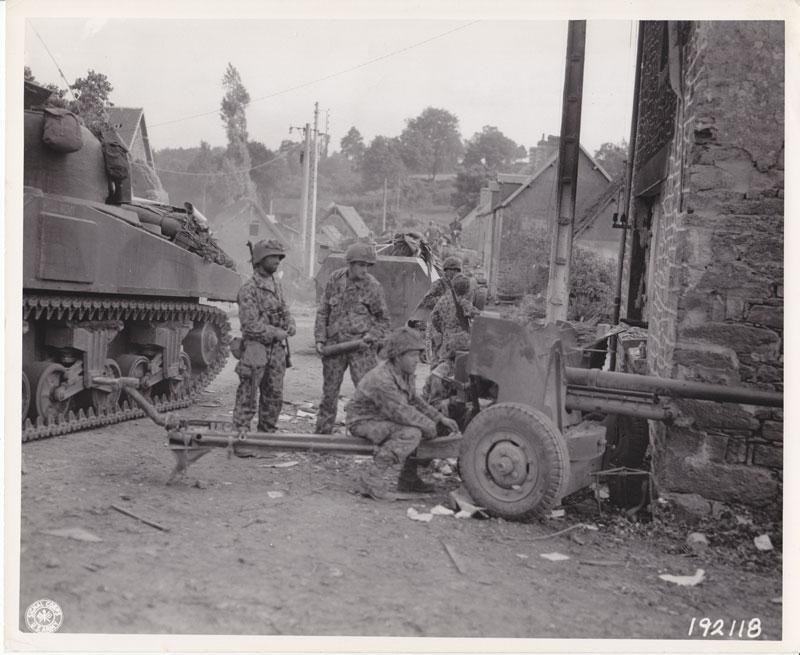-
Contributing Member


12 May 20 Garand Picture of the Day

Information
 |
Warning: This is a relatively older thread
This discussion is older than 360 days. Some information contained in it may no longer be current. |
|
He is no fool who gives what he cannot keep to gain that which he cannot lose
There are no great men, only great challenges that ordinary men are forced by circumstances to meet.
-
The Following 13 Members Say Thank You to Mark in Rochester For This Useful Post:
#1oilman,
25-5,
30-06_mike,
Bill Hollinger,
Bob Womack,
ed skeels,
Flying10uk,
frankderrico,
Jonzie,
lgr1613,
Ovidio,
rayg,
RazorBurn
-
05-07-2020 07:11 PM
# ADS
Friends and Sponsors

-
Advisory Panel


Neat pic, Sherman with the added plate outside the ammo bin, troops wearing the early camouflage that lasted days after landing...
-
-
-
Moderator
(M1 Garand/M14/M1A Rifles)


Yeah, but where's their mounted Garand spotting rifle?
spotting rifle? 
Bob
"It is said, 'Go not to the elves for counsel for they will say both no and yes.' "
Frodo Baggins to Gildor Inglorion, The Fellowship of the Ring
-
-
Advisory Panel



Originally Posted by
Bob Womack

Did they make one for howitzers? Or anti tank guns...
-
-
Legacy Member

with the added plate outside the ammo bin
I always wondered the reason for those plates welded on the sides of Sherman tanks. Would it have been a factory fitment or added later in the field?
Is that a German 251 half track, in the background, behind the 2nd soldier from the left?
251 half track, in the background, behind the 2nd soldier from the left?
-
-
Contributing Member


Applique Armor
[QUOTE=Flying10uk;474586]I always wondered the reason for those plates welded on the sides of Sherman tanks. Would it have been a factory fitment or added later in the field?
Added for an aiming point for German tankers
tankers


At first, a partial remedy to ammunition fires in the M4 was found in 1943 by welding 1-inch thick (25 mm) appliqué armor plates to the sponson sides over the ammunition stowage bins, though there was doubt that these had any effect. Later models moved ammunition stowage to the hull floor, with water jackets surrounding each stowage bin. The practice, known as wet stowage, reduced the chance of fire after a hit to about 15 percent. The Sherman gained grim nicknames like "Zippo" (after the cigarette lighter), "Ronson" (because "it lights the first time, every time"). The latter story has been challenged on the grounds that Ronson did not begin using the slogan until the 1950s. [103] and "Tommycooker" (by the Germans, who referred to British soldiers as "Tommies"; a tommy cooker was a World War I-era trench stove). Fuel fires occasionally occurred, but such fires were far less common and less deadly than ammunition fires. In many cases, the fuel tank of the Sherman was found intact after a fire. Tankers described "fierce, blinding jets of flame", which is inconsistent with gasoline-related fires
soldiers as "Tommies"; a tommy cooker was a World War I-era trench stove). Fuel fires occasionally occurred, but such fires were far less common and less deadly than ammunition fires. In many cases, the fuel tank of the Sherman was found intact after a fire. Tankers described "fierce, blinding jets of flame", which is inconsistent with gasoline-related fires
He is no fool who gives what he cannot keep to gain that which he cannot lose
There are no great men, only great challenges that ordinary men are forced by circumstances to meet.
-
The Following 5 Members Say Thank You to Mark in Rochester For This Useful Post:
-
Advisory Panel


A tank cooking from the propellant of the ammo is indeed fierce, it's like a blowtorch with the oxygen turned way up. To educate in what it would look like, take a can of smokeless powder and set it on the ground and light the open neck. The rush of flame is identical. If the ammo cooks or goes off, the tank is separated in several pieces.
During action the remains of unburned powder floated around the turret and could catch fire in little whiffs like coal dust. A friend of mine said he would constantly be getting singed because he was hairy like a gorilla...
-
 Information
Information















 PM
PM














